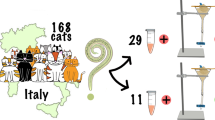Abstract
Aelurostrongylus abstrusus is a lungworm of the domestic cats distributed worldwide. Its presence, however, is often underestimated due to limitation of common coprological diagnostic techniques. The present study reports, for the first time, the use of the FLOTAC technique for A. abstrusus diagnosis in feline faecal samples with results compared to the following three standard copromicroscopic techniques: the Baermann technique, the McMaster technique and the Wisconsin technique. The comparison study showed that the FLOTAC technique produced mean larvae per gram of faeces significantly (P < 0.05) greater than that produced by the other more widely used diagnostic tools. Thus, the FLOTAC technique can be utilised for quantifying lungworm larva burdens in feline faecal samples because of its high sensitivity, as already shown for various parasites of veterinary and human importance.
Similar content being viewed by others
References
Capuano F, Landolfi MC, Pinto O, Cringoli G (1995) Presenza di Aelurostrongylus abstrusus (agente della broncopolmonite verminosa del gatto) in due gattini della Campania. Boll IZS 2:103–109
Cox DD, Todd AC (1962) Survey of gastrointestinal parasitism in Winsconsin dairy cattle. J Am Vet Med Assoc 141:706–709
Cringoli G (2006) FLOTAC a novel apparatus for a multivalent faecal egg count technique. Parassitologia 48:381–384
Cringoli G, Rinaldi L, Veneziano V, Capelli G, Scala A (2004) The influence of flotation solution, sample dilution and the choice of McMaster slide area (volume) on the reliability of the McMaster technique in estimating the faecal egg counts of gastrointestinal strongyles and Dicrocoelium dendriticum in sheep. Vet Parasitol 123:121–131
Egwang TJ, Slocombe JO (1982) Evaluation of the Cornell–Wisconsin centrifugal flotation technique for recovering trichostrongylid eggs from bovine feces. Can J Comp Med 46:133–137
Epe C, Ising-Volmer S, Stoye M (1993) Parasitological fecal studies of equids, dogs, cats and hedgehogs during the years 1984–1991. Dtsch Tierarztl Wochenschr 100:426–428
Epe C, Coati N, Schnieder T (2004) Results of parasitological examinations of faecal samples from horses, ruminants, pigs, dogs, cats, hedgehogs and rabbits between 1998 and 2002. Dtsch Tierarztl Wochenschr 6:243–247
Grabarevic Z, Curic S, Tustonja A, Artukovic B, Šimec Z, Ramadan K, Zivicnjak T (1999) Incidence and regional distribution of the lungworm Aelurostrongylus abstrusus in cats in Croatia. Vet Arh 69:279–287
Grandi G, Calvi LE, Venco L, Paratici C, Genchi C, Memmi D, Kramer LH (2005) Aelurostrongylus abstrusus (cat lungworm) infection in five cats from Italy. Vet Parasitol 134:177–182
Lopéz C, Panadero R, Paz A, Sánchez-Andrade R, Díaz P, Diez-Baños P, Morrondo P (2005) Larval development of Aelustrongylus abstrusus (Nematoda, Angiostrongylidae) in experimentally infected Cernuella (Cernuella) virgata (Mollusca, Helicida). Parasitol Res 95:13–16
MAFF (1986) Manual of veterinary parasitological laboratory techniques. Ministry of Agriculture, Fisheries and Food, reference book 418. H.M.S.O., London
Payo-Puente P, Botelho-Dinis M, Carvaja Urueña AM, Payo-Puente M, Gonzalo-Orden JM, Rojo-Vazquez F (2008) Prevalence study of the lungworm Aelurostrongylus abstrusus in stray cats of Portugal. J Feline Med Surg 10:242–246
Pennisi MG, Niutta PP, Giannetto S (1995) Lungworm disease in cats caused by Aelurostrongylus abstrusus. Tijdschr Diergeneeskd 120:263–266
Rinaldi L, Calabria G, Carbone S, Carrella A, Cringoli G (2007a) Crenosoma vulpis in dog: first case report in Italy and use of the FLOTAC technique for copromicroscopic diagnosis. Parasitol Res 101:1681–1684
Rinaldi L, Russo T, Schioppi M, Pennacchio S, Cringoli G (2007b) Passalurus ambiguus: new insights into copromicroscopic diagnosis and circadian rhythm of egg excretion. Parasitol Res 101:557–561
Traversa D, Lia RP, Iorio R, Boari A, Paradies P, Capelli G, Avolio S, Otranto D (2008) Diagnosis and risk factors of Aelurostrongylus abstrusus (Nematoda, Strongylida) infection in cats from Italy. Vet Parasitol 153:182–186
Utzinger J, Rinaldi L, Lohourignon LK, Rohner F, Zimmermann MB, Tschannen AB, N’Goran EK, Cringoli G (2008) FLOTAC: a new sensitive technique for the diagnosis of hookworm infections in humans. Trans R Soc Trop Med Hyg 102(1):84–89
Willard MD, Roberts RE, Allison N, Grieve RB, Escher K (1988) Diagnosis of Aelustrongylus abstrusus and Dirofilaria immitis infections in cats from a human shelter. J Am Vet Med Assoc 192:913–916
Author information
Authors and Affiliations
Corresponding author
Rights and permissions
About this article
Cite this article
Gaglio, G., Cringoli, G., Rinaldi, L. et al. Use of the FLOTAC technique for the diagnosis of Aelurostrongylus abstrusus in the cat. Parasitol Res 103, 1055–1057 (2008). https://doi.org/10.1007/s00436-008-1091-4
Received:
Accepted:
Published:
Issue Date:
DOI: https://doi.org/10.1007/s00436-008-1091-4




